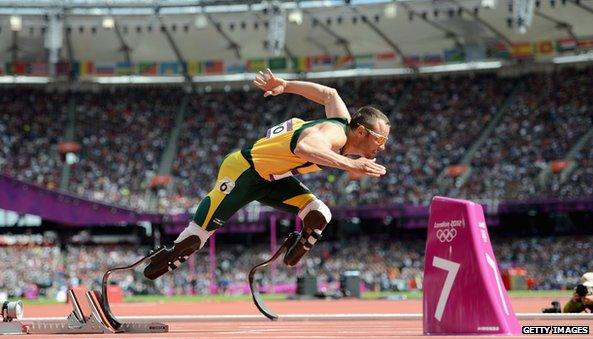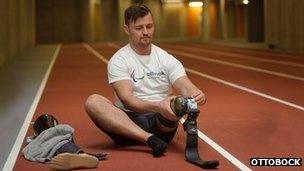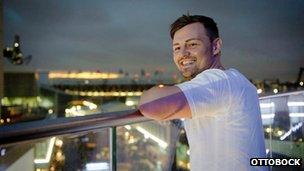Paralympics: Should technology push athletes beyond their limits?
- Published

Oscar Pistorius came last in his Olympic semi-final - but in doing so broke many boundaries in Paralympic sport
Oscar Pistorius was never going to win the race.
Just as well, some pundits agreed - as if there was a chance he would have done, he may not have been allowed to run it in the first place.
As the 400m semi-final at the London 2012 Olympic Games drew to a close, he may have been well off the pace, but he was well ahead of his time.
As the first double leg amputee to compete against able-bodied opponents at the Olympics, Pistorius has fired the starting pistol on arguably the most significant debate elite sport will ever encounter.
Soon, athletes using technology to enhance their bodies will be able to jump higher, leap farther and last longer - stretching our concept of what it means to push the human body to the limit.
It's a limit no longer being pushed out on the track but in a scientific lab.
'Look out the window'
It is in one such lab, within the Ottobock factory in Germany, that Heinrich Popow had his running blade developed. The Kazakhstan-born athlete - who moved to Germany as a seven-year-old - lost his left leg to cancer when he was nine.

Heinrich Popow has his prosthetic leg designed and manufactured at the Ottobock factory in Germany
In its place, a carbon-fibre masterpiece that will enable him to compete in the 100m and 200m, as well as the long jump.
"Before my amputation I was playing football, just like every little kid," Popow told the BBC.
"It was not hard for me having an amputation, [but] it was hard for me to look out of the window and see the little kids playing football outside."
Nate Williams is one of several engineers at the Ottobock Factory who has helped Popow forge his athletics career.
The factory has been making prosthetics for more than 85 years. Its founder, Otto Bock, pioneered mass-production prosthetics - a necessary step to handle a huge influx of war-hit amputees with little money to support them.
"We have a major research and development facility here," Mr Williams says.
"The products are designed, manufactured and tested - all at this location."
Popow's blade is built up layer-by-layer before being placed into an autoclave and subjected to a high-powered vacuum.

Ottobock also produces equipment for Australian Paralympian Kelly Cartwright
"It comes in layers that are 0.1mm thick up to almost 2mm," says Mr Williams.
"We've stacked those layers one on top of the other. We can orient the fibres in a certain specific direction so that we can maximise the stiffness and the strength."
Nano-technology
Since those first prosthetics were made at the Ottobock factory in 1919, the purpose of Paralympic technology has centred on compensating for something - usually a limb - that is missing.
Yet, in the coming years, we may look back to Oscar Pistorius' eighth place finish as the beginning of something far bigger.
"Rather than thinking about prosthetic devices as quite clunky apparatus that we stick on our bodies, a more likely scenario is where we have nano-technology devices under our skin and improving our physical properties without us really noticing it," says Andy Miah, professor of ethics and emerging technology at the University of the West of Scotland.
Where some athletes today decide to utilise illegal performance-enhancing drugs, we could find ourselves with sportsmen and women with performance-enhanced bodies.
"In the future we will think of everybody as already disabled," Prof Miah says. "And it won't be a question of whether people that have disabilities are better or worse.
"It's about trying to ensure that everyone with their particular limitations is able to use technology in a way that optimises their performance."
Unsurprisingly, sports authorities are keeping a close eye on whether technology is being unfairly used, which already has a nickname - techno-boosting.
International Paralympics Committee's (IPC) medical and scientific director Peter van de Vliet told the BBC performance-enhancing technology was monitored as strictly as medication.
"Whatever equipment you bring to the field of play, the critical endeavour is the human performance, rather than the impact of the technology and equipment.
"We cannot deny we should not hamper the development of technology. It is something where these two communities need to find each other and then agree on what can be put into the rules at which moment in time."
'Interaction celebration'
Mr Van de Vliet argues technology goes too far at the point at which it pushes performance beyond human limits.
But Prof Miah, like many in the scientific community, says "human limit" is an unenforceable boundary that is anti-sport.

For Heinrich Popow, the ethical debate over technology has been put to back of his mind during the Games
"The spirit of sport is such that everyone believes we can go faster, we can jump higher, we can lift more weight - and technology is a part of that process.
"The moment that a foot hits the track is a technological interaction. The idea that sports are somehow a celebration of human natural talents is misleading. I think it's a celebration of the interaction of biology with technology."
Popow is preparing for an altogether different celebration - one of his own triumph over adversary.
His technology is not about making him somebody he is not, but someone he has always strived to be.
"I often get asked if I would like to get my leg back. I would say, 'No, never ever'. I just got one bad thing in my life - and got 100 positive things now. I'm really happy with what I have."
The interviews in this article were first heard on Click from the BBC World Service. To listen to their Paralympic technology special, click here.
- Published15 May 2012